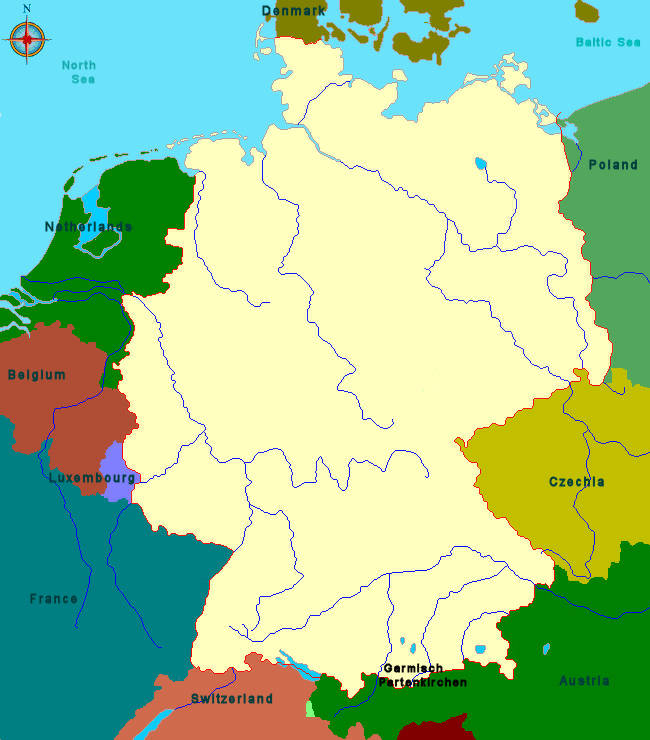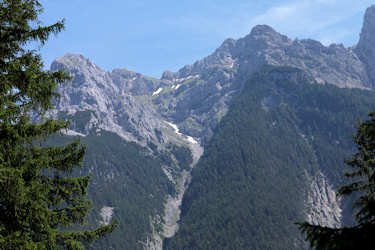Germany

Historie
The Neander Valley was the location where the first ever non-modern human fossil was discovered, the new species of human was
named Neanderthal man. The Neanderthal fossils are known to be 40.000 years old. Evidence of modern humans, similarly dated,
has been found in caves in the Swabian Jura near Ulm. The finds include 42.000-year-old bird bone and mammoth ivory flutes which
are the oldest musical instruments ever found.
The Ahrensburg culture (15.000-10.000 BC) was a late Upper Paleolithic nomadic hunter culture in north-central Europe during
the Younger Dryas, the last spell of cold at the end of the Weichsel glaciation resulting in deforestation and the formation of
a tundra with bushy arctic white birch and rowan. The most important prey was the wild reindeer.
The first groups of early farmers different from the indigenous hunter-gatherers to migrate into Europe came from a population in western
Anatolia at the beginning of the Neolithic period between 10,000 and 8,000 years ago.
Central Germany was one of the primary areas of the Linear Pottery culture (5500–4500 BC), which was partially contemporary
with the Ertebølle culture (5300–3950 BC) of Denmark and northern Germany. The construction of the Central European Neolithic
circular enclosures falls in this time period with the best known and oldest being the Goseck circle, constructed c. 4900 BC.
Afterwards, Germany was part of the Rössen culture (4600–4300 BC), Michelsberg culture (4400–3500 BC) and Funnelbeaker
culture (4600–2800 BC).
The settlers of the Corded Ware culture (2900–2350 BC), that had spread all over the fertile plains of Central Europe during
the Late Neolithic were of Indo-European ancestry.
By the late Bronze Age, the Urnfield culture (1300–750 BC) had replaced the Bell Beaker (2800–1800 BC), Unetice
(2300–1600 BC) and Tumulus cultures (1600–1200 BC) in central Europe, whilst the Nordic Bronze Age (1800–600 BC) had
developed in Scandinavia and northern Germany. The Hallstatt culture, which had developed from the Urnfield culture, was
the predominant Western and Central European culture from the 12th to 8th centuries BC and during the early Iron Age (8th to 6th
centuries BC). It was followed by the La Tène culture (5th to 1st centuries BC).
The Germanic tribes are thought to date from the Nordic Bronze Age (1700–500 BC). From southern Scandinavia and north Germany,
they expanded south, east and west from the 1st century BC, coming into contact with the Celtic tribes of Gaul as well as Iranian,
Baltic, and Slavic tribes in Central and Eastern Europe.
Under Augustus, the Roman Empire began to invade lands inhabited by the Germanic tribes, creating a short-lived Roman province
of Germania between the Rhine and Elbe rivers. In 9 AD, three Roman legions were defeated by Arminius in the Battle of
the Teutoburg Forest. Consequently, Rome resolved to permanently establish the Rhine/Danube border and refrain from further
territorial advance into Germania.
Around 260 AD, the Germanic peoples broke into Roman-controlled lands. After the invasion of the Huns in 375 AD, and with the decline of
Rome from 395 AD, Germanic tribes moved further south-west. Simultaneously several large tribes formed in what is now Germany and
displaced the smaller Germanic tribes. Large areas were occupied by the Franks, and Northern Germany was ruled by the
Saxons and Slavs.
By 500, Clovis I had united all the Frankish tribes, ruled all of Gaul and was proclaimed King of the Franks between 509 and 511.
During the 5th and 6th centuries the Merovingian kings conquered the Thuringii, the Kingdom of the Burgundians and the principality
of Metz and defeated the Danes, the Saxons and the Visigoths.
After the death of Frankish king Pepin the Short in 768, his oldest son Charlemagne consolidated his power over and
expanded the kingdom on the conquest of the Slavs and Pannonian Avars in the east and all Germanic tribes, such as the Saxons and the
Bavarians. In 800, Charlemagne was crowned emperor and founded the Carolingian Empire, which was divided in 843 among his heirs.
The Holy Roman Empire included the eastern portion of Charlemagne's original kingdom and emerged as the strongest. Its territory stretched
from the Eider River in the north to the Mediterranean coast in the south.
The Ottonian emperors (919–1024) consolidated several major duchies and the German king Otto I was crowned Holy Roman Emperor
of these regions in 962. In 996 Gregory V became the first German Pope, appointed by his cousin Otto III, whom he shortly after
crowned Holy Roman Emperor. The Holy Roman Empire absorbed northern Italy and Burgundy under the reign of the Salian emperors (1024–1125).
Under the Hohenstaufen emperors (1138–1254), German princes encouraged German settlement to the south and east ("Ostsiedlung").
Members of the Hanseatic League, mostly north German towns, prospered in the expansion of trade.
The population declined starting with the Great Famine in 1315, followed by the Black Death of 1348–1350.
In 1517, the monk Martin Luther published a pamphlet with "95 Theses" that he posted in the town square of Wittenberg
and handed copies of to feudal lords. The list detailed 95 assertions, he argued, represented "corrupt practice of the Christian faith and
misconduct within the Catholic Church". The Protestant Reformation was the first successful challenge to the Catholic Church
and began in 1521 as Luther was outlawed at the Diet of Worms after his refusal to repent.
The Peace of Augsburg (1555) officially ended the religious struggle between the two groups and made the legal division of Christianity
permanent within the Holy Roman Empire, allowing rulers to choose either Lutheranism or Roman Catholicism as the official confession of
their state.
The 1618 to 1648 Thirty Years' War, that took place almost exclusively in the Holy Roman Empire has its origins, in the unsolved
and recurring conflicts of the Catholic and Protestant factions. The Catholic emperor Ferdinand II attempted to achieve the
religious and political unity of the empire, while the opposing Protestant Union forces were determined to defend their religious rights.
The war ended in 1648 with the Peace of Westphalia. It resulted in increased autonomy for the constituent states of the Holy Roman
Empire, limiting the power of the emperor. Most of Alsace was ceded to France, Western Pomerania and Bremen-Verden
were given to Sweden as Imperial fiefs, and the Netherlands officially left the Empire.
The House of Habsburg held the imperial crown from 1438 until the death of Charles VI in 1740. From 1740, dualism between the
Austrian Habsburg Monarchy and the Kingdom of Prussia; ruled by the Hohenzollern dynasty, dominated the German states in the 18th
century.
Following the fall of Napoleon, the Congress of Vienna (1814) founded the German Confederation, a loose league of 39 sovereign states.
The appointment of the Austrian king as the permanent president of the Confederation reflected the Congress's failure to accept Prussia's
influence among the German states, and acerbated the long-standing competition between the Hohenzollern and Habsburg interests.
After the French defeat in the Franco-Prussian War (1870-1871), the German princes proclaimed the founding of the German Empire
in 1871 at Versailles, uniting all scattered parts of Germany except Austria. Prussia was the dominant constituent state of the new empire;
the King of Prussia ruled as its Kaiser, and Berlin became its capital.
The assassination of Austria's crown prince on 28 June 1914 triggered World War I. After four years of warfare, in which approximately
two million German soldiers were killed, a general armistice ended the fighting on 11 November.
In the German Revolution (November 1918), Emperor Wilhelm II and the ruling princes abdicated their positions, and Germany
was declared a federal republic. Germany's new leadership signed the Treaty of Versailles in 1919, accepting defeat by the
Allies. Germans perceived the treaty as humiliating, which was seen by historians as influential in the rise of Adolf Hitler.
In the Spring of 1940, Germany conquered Denmark and Norway, the Netherlands, Belgium, Luxembourg, and France. By 1942 Germany and other
Axis powers controlled most of continental Europe and North Africa but following the Soviet Union's victory at the Battle of
Stalingrad, the allies' reconquest of North Africa and invasion of Italy in 1943, German forces suffered repeated military defeats.
In June 1944 the Western allies invaded France and the Soviets reconquered much of Eastern Europe. Following Hitler's suicide during
the Battle of Berlin, German armed forces surrendered on 8 May 1945, ending World War II in Europe.
After Germany surrendered, the Allies partitioned Berlin and Germany's remaining territory into four military occupation zones. The
western sectors, controlled by France, the United Kingdom, and the United States, were merged on 23 May 1949 to form the Federal Republic
of Germany; on 7 October 1949, the Soviet Zone became the German Democratic Republic. They were informally known as
"West Germany" and "East Germany". East Germany selected East Berlin as its capital, while West Germany chose
Bonn as a provisional capital, to emphasise its stance that the two-state solution was an artificial and temporary status quo.
In 1989, Hungary decided to dismantle the Iron Curtain and open its border with Austria, causing the emigration of thousands of
East Germans to West Germany via Hungary and Austria. Unable to stop the growing civil unrest, Erich Honecker was forced to
resign in October, and on 9 November, East German authorities unexpectedly allowed East German citizens to enter West Berlin and West Germany.
This led to the acceleration of the process of reforms in East Germany that ended with the dissolution of East Germany and the
German reunification that came into force on 3 October 1990.
Since reunification (1990), Germany has taken a more active role in the European Union. Together with its European partners Germany signed
the Maastricht Treaty in 1992, established the Eurozone in 1999.
In the 2005 elections, Angela Merkel became the first female chancellor. In September 2021 Germany's centre-left Social Democrats
(SPD) narrowly won the federal election, ending 16 years of conservative-led rule under Angela Merkel.
On 8 December 2021, Social Democrat Olaf Scholz was sworn in as Germany's new chancellor. He formed a coalition government with
the Green Party and the liberal Free Democrats.
In have visited Germany in june 2024
During this trip, i have seen Garmisch-Partenkirchen
Please let me know when you're having questions.
i would be pleased to help you.
Things to do and other tips
